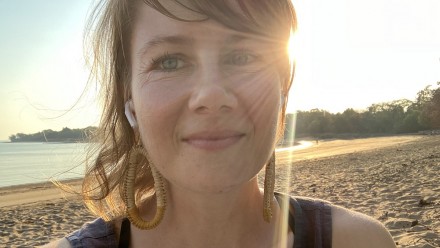From indecision to pathology and podcasting
Written by Barb Corapi
Like many young people, Dr Travis Brown had no idea what career path he wanted to pursue after high school. By his own account, he was the ‘poster boy of indecision.’
He followed his interest in computing, which led to a corporate career at one of the big 4 consulting firms. But after a couple of years, he realised it wasn’t for him.
“It was a lot of paperwork and report writing and the most frustrating thing was that I never got to see the fruits of my labour,” Dr Brown explains.
Knowing he wanted a job that was more hands-on, Dr Brown went back to university to study science with the intention of becoming a physiotherapist. As he undertook his science degree he realised it was the field of medicine that got to play with all the interesting toys like MRIs, ultra-sounds and CT scans, so he moved into medical science.
Today, Dr Brown looks back fondly at his time at the ANU Medical School. He was accepted into the then newly created Doctor of Medicine and Surgery program in 2004 and was a member of the first graduating class. “There was a sense of excitement from everyone within the School – from the tutors to the professors and of course the students. The enthusiasm was palpable.”
Originally from Ballarat, it was Dr Brown’s intention to go back to his hometown to practice once he graduated. However, after a couple of years as a junior doctor he realised the work wasn’t what he had anticipated.
“As a junior doctor I was assessing, triaging, organising testing and doing mountains of paper work. It was all about getting things done and it didn’t feel enough.”
“I’d go to multidisciplinary meetings at the hospital and notice that the pathologists were relaxed. They had time to take questions and respond in detail.”
Dr Brown credits Dr Jane Dahlstrom OAM, Professor of Pathology at ANU Medical School, as one of the reasons he found pathology appealing.
“I think Professor Dahlstrom skewed my view of pathology in a very positive way,” he chuckles. “I remember her being so enthusiastic and approachable when I was a student, and she created an environment where asking questions was encouraged. I thoroughly enjoyed learning about diseases and the academic nature of pathology.”
Since becoming a general pathologist, Dr Brown has had the opportunity to combine his knowledge of computer programming with his interest in pathology to create a simple, yet highly effective way to record and report on certain cancers.
“When it comes to IT systems in pathology the saying ‘if it ain’t broke don’t fix it’ applies. Some programs are decades old and advances are slow. It was the frustration of not having a way to record structured information about cancer protocols that made me decide to put my computing skills to work.” Dr Brown advises.
Having spent the last ten years developing and tweaking the Structured Pathology Reporting programs, they are now gaining traction with the Royal College of Pathologists of Australasia and the International Collaboration on Cancer Reporting.
“The reports can benefit clinicians, oncologists and general practitioners. Our hope is that the programs will be used by lower to middle income countries to get more consistent reporting at a minimal cost, while collecting rich data to support cancer research.”
In his spare time, Dr Brown enjoys podcasting about all things pathology. “I’ve always loved story-telling, and I do like to talk,” he jokes.
“I started my current role at the beginning of the pandemic when everything was in flux and people couldn’t connect in person. The idea to run a podcast was the thinking of some of my colleagues and I was happy to jump on board as a co-host for a series called This Pathological Life.”
“We tell some very interesting stories, like episode 24 which discusses the women of World War 1 who are known to history as The Radium Girls. They were responsible for painting the hands on clocks (with radioactive radium) to glow in the dark but had fatal consequences for the women.”
The podcast series is ranked in the top 10 of the medicine and science category for the Podcast Awards – The People’s Choice.














